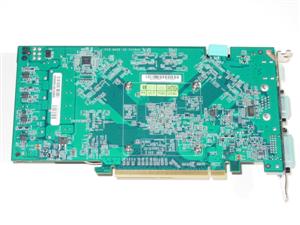Gigabyte GV-N250OC-1GI GeForce GTS 250
Gigabyte ships their GTS 250 in a non-ostentatious package - small and light with black coloring and a menacing robot on the front. Cleverly integrated into the artwork is a graphical representation of Gigabyte's UDV technology, short for Ultra Durable VGA. Similar to what they have done with their Ultra Durable line of motherboards, UDV consists of 2 oz. copper layers in the PCB, Japanese solid capacitors, Ferrite core chokes, and Lower RDS(on) MOSFETS, all of which are designed to reduce temperature and increase power efficiency which should also result in higher overclock speeds. Checking inside the package we found hardly any surprises: just the GV-N250OC-1GI itself with a DVI-to-HDMI adapter, S/PDIF audio cable, 6-pin power cable and the user's manual and drivers/utility disc. Gamer HUD Lite is the proprietary software to be found on that CD, and it allows the user to not only monitor and adjust the voltage to the GPU, but also tweak the core, shader, and memory clock speeds as well. And, although installing or replacing a graphics card is a relatively simple process, Gigabyte's manual does a decent job at explaining not only how to properly seat the card, but also which cables need to be installed where and a briefing on how to get the most out of the card using NVIDIA's Control Panel. The final piece of UDV is the inclusion of "Tier 1" memory from either Samsung or Hynix. In this case, we found 1 GB of Hynix H5RS1H23MFR-N2C GDDR3 that is rated for a frequency of 1200 MHz. On the box, the memory is noted as being "overclocked", although this is the memory speed that the GTS 250 (and 9800 GTX+) is currently rated, while the GPU itself remains untouched. Thus, it appears that a good deal of the "OC" in the product name will come after the fact and by the user, aided in part by the Zalman cooler placed onboard.
The Hynix memory is left exposed, but should receive some cooling from the airflow emanating from the fan embedded within the Zalman VF1050 cooler - a copper/aluminum hybrid heatsink that covers nearly the entire length of the card. Four nickel-plated heatpipes conduct heat away from the aluminum base and run through the copper fins - two towards the front of the mechanism and two placed a little further back. Although the Zalman VF1050 is massive dimensionally, the weight of the card overall is not excessive by any means. MOSFETs and chokes are spaced evenly at the far end of the card, and, like the memory, do not receive any direct forms of cooling. Although a close cousin to the 9800 GTX+, the GTS 250 is noticeably shorter and more compact and only requires a single 6-pin power connection. Gigabyte has a made a habit of capping the open ports and connections such as the SLI bridge, which we assume is to protect them during shipping or storage. While we can't remember a time where we had a problem in this regard, we surely applaud them for at least thinking of the consumer first, and cost (no matter how minor it might be) second. There is also only a single SLI connection along the top of the card, quickly dashing any thoughts of an inexpensive 3-Way SLI setup, especially in light of the news that 9800 GTX+ and GTS 250 cards can be linked together. Output options includes native HDMI, VGA (D-Sub) and DVI-I as well as S/PDIF audio for connecting to an HDMI TV. These options make the GV-N250OC-1GI a good choice for not only mainstream gaming PCs, but higher-end HTPC boxes as well.
















